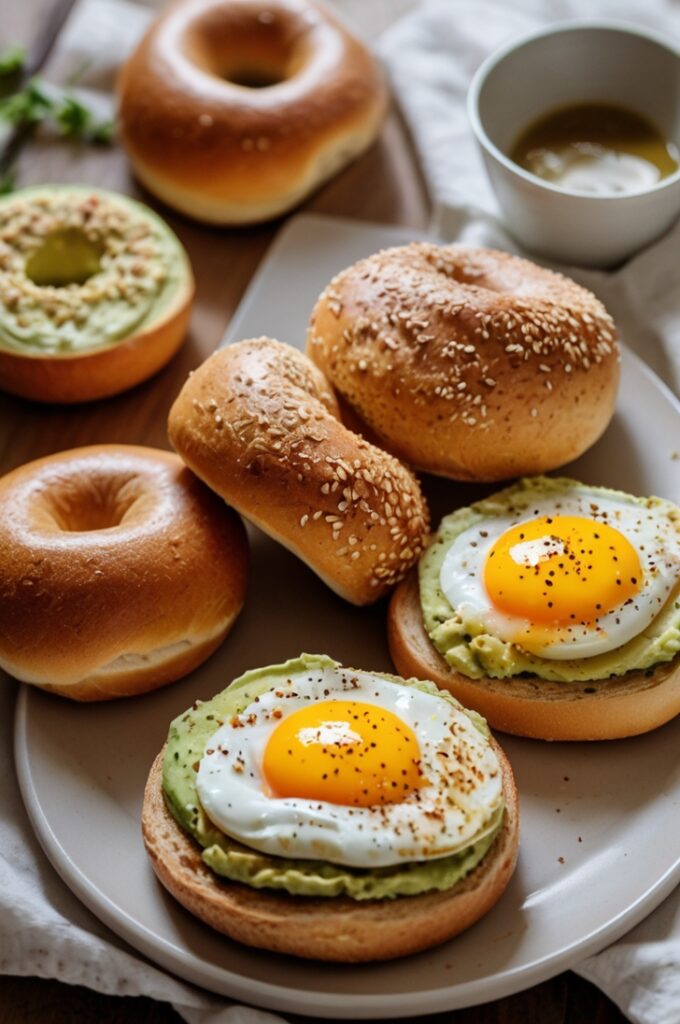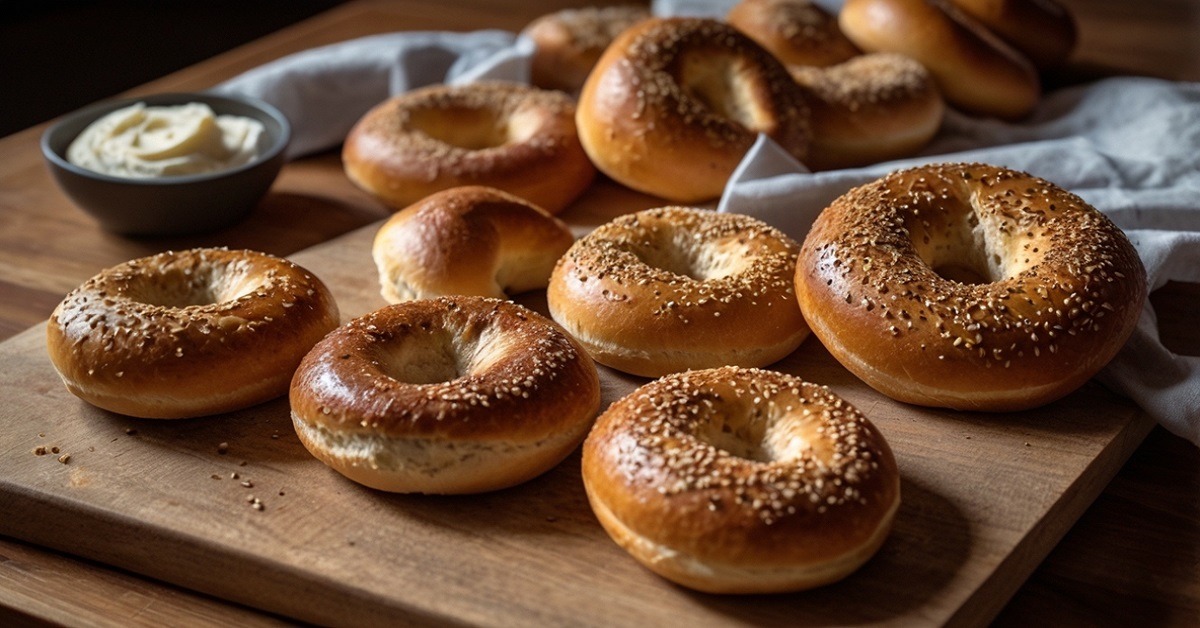New York Style Sourdough Bagels aren’t just food they’re a full-blown experience. You ever stand over your sink at 7 a.m., bagel in one hand, cream cheese on your cheek, wondering if perfection actually exists? It does.
And in New York, it has a name: the sourdough bagel. But not the kind that flops in your mouth like a damp sponge or tears like a dry biscuit. Nah. I’m talkin’ chewy, crusty, tangy, golden rounds that fight back just enough when you bite.
This recipe? It’s got that snap when you tear it open. That little bit of resistance on the chew. The kind of bagel that could stand up to a skyscraper’s worth of pastrami and still ask for more. And yes it’s sourdough. Slow fermented. Old-school. Deep flavor. None of that commercial, yeasted shortcut stuff.
What Makes These Bagels So Dang Special?

First, they’re naturally leavened meaning no commercial yeast. Just sourdough starter. That’s what brings the tang and complexity. It’s what makes ‘em taste like they’ve got history.
Second, they’re boiled before baked, like all legit bagels should be. This gives that signature glossy crust and dense chew. We even sneak in a little malt syrup into the boil for that subtle sweetness and traditional bagel-shop flavor.
And third? The flour. High-protein, high-gluten bread flour. This ain’t no cookie dough, friend. You need strength and structure for that signature chew.
Let’s go deep into this like 12-hour-fermentation-deep.
Ingredients & Substitutions
- 500g bread flour (You must use high-gluten or bread flour. All-purpose is for pancakes, not bagels.)
- 100g active sourdough starter (at 100% hydration fed and bubbly)
- 280–300g water, lukewarm (Start low; add more if the dough feels too stiff)
- 10g salt
- 20g barley malt syrup (for the dough + extra for boiling)
- Optional toppings: sesame, poppy, everything spice, onion flakes, flaky salt
Substitution Notes:
- Can’t find malt syrup? Try honey or molasses in a pinch. Not the same, but not criminal.
- Gluten-free flour? Sorry, pal. Sourdough bagels need gluten. This ain’t that recipe.
- No sourdough starter? You’re in the wrong room. (Just kidding sorta. You can sub 1 tsp instant yeast and skip the long ferment. But you’ll lose a lot of the soul.)
Pro Ingredient Insight:
Use fresh malt syrup not the dusty jar in the back of your grandma’s pantry. It brings color and flavor that’s hard to mimic. If your starter smells like gym socks, don’t panic it’s probably fine. Unless it’s fuzzy. Then it’s not.
Step-by-Step Instructions

Step 1: Mix & Knead
In a large bowl or stand mixer, combine your starter, water, and malt syrup. Stir to dissolve.
Add in the flour and salt. Mix until a shaggy dough forms.
Now knead. Hard. At least 10–12 minutes by hand, or 8 with a dough hook. The dough should be very stiff like borderline “did I mess this up?” stiff. That’s correct.
If your arms don’t hurt, you’re not done.
💡 Pro Tip: Don’t add more water too soon. This dough starts rough but smooths out beautifully once you knead long enough.
Step 2: Bulk Fermentation (Room Temp)
Cover the dough and let it ferment at room temperature for 4–6 hours, until it rises about 30–40%. It won’t double like a yeasted dough. Don’t force it.
🛑 Mistake Alert: Overproofing here makes sad, flat bagels. Trust your dough not the clock.
Step 3: Shape the Bagels
Turn dough onto a clean surface. Divide into 8 equal pieces (about 110–115g each).
Roll each piece into a tight ball. Rest 10 minutes.
Then poke a hole through each ball with your finger, stretch into a 2-inch ring, and place on a parchment-lined sheet pan.
💬 Tiny chef whisper: Don’t over-stretch. The hole should be tight; it’ll relax overnight.
Step 4: Cold Proof (Refrigerate Overnight)
Cover the pan loosely and refrigerate 12–16 hours. This is where the flavor builds.
❄️ Fridge Tip: Make sure they’re covered or they’ll dry out. No one likes crusty bagels before they even bake.
Step 5: Boil & Bake
Preheat oven to 230°C (450°F). Bring a wide pot of water to a simmer. Add 1 tablespoon of malt syrup.
Drop in bagels (3–4 at a time). Boil 30 seconds per side. They’ll puff. They’ll smile.
Place back on the baking tray, sprinkle on toppings immediately.
Bake 18–22 minutes until deeply golden. Not blond. Bagels should have color like a bronzed lifeguard.
The Science & Techniques That Matter
Why Boiling Matters
Boiling gelatinizes the outer starches, sealing in the crust and giving that unmistakable chew. Without it, you’ve just made round bread. Sad.
Malt syrup in the water? It’s not just for color. It balances the tang of the sourdough and creates a crisp finish that snaps when you bite.
Why the Dough is So Stiff
Hydration’s low on purpose. That stiff dough forms tight gluten networks. That’s the foundation of structure. You want a bagel that bites back a little not something you can fold like a taco.
Cold Fermentation
This is where the sourdough magic happens. The long, slow chill develops acids and aromas that give these bagels their tangy backbone.
🧪 Fermentation Fun Fact: Lower temps slow yeast activity but let lactic acid bacteria thrive. That’s your flavor goldmine.
Serving & Pairing Suggestions

Slice ’em while warm and slather with cold cream cheese. The contrast is criminal.
Top with lox, capers, red onion, and dill. Classic.
Toast lightly and pile on scrambled eggs, avocado, and chili oil if you’re feeling spicy.
Pair with a proper New York deli coffee or a bracing black tea. (None of that vanilla almond soy caramel latte nonsense.)
📸 Pro Plating Tip: Cut one bagel in half, smear each side dramatically with cream cheese, sprinkle some chives, and let a few capers roll off onto the plate for that “I woke up like this” shot.
FAQs About New York Style Sourdough Bagels
1. Can I freeze the sourdough bagels?
Yes! Slice them first, wrap tightly, and freeze. Reheat in a toaster or oven. They’re still amazing.
2. Why do my bagels flatten in the fridge?
Overproofing or too much water in the dough. Make sure the dough’s stiff and you chill them promptly.
3. Can I skip the cold proof?
Technically yes, but don’t. You’ll lose all that developed sour flavor and texture. They’ll taste meh.
4. How can I make them gluten-free?
Honestly? You can’t not if you want real bagel texture. But you can use this recipe as inspiration for GF adaptations.
5. Why aren’t my bagels getting a golden crust?
Could be your oven’s not hot enough, or you skipped malt syrup in the boil. That’s where the magic’s at.
There you have it.
A real-deal, slow-rise, chewy-crusted, sourdough-kissed New York style bagel.
Made by hand. Loved by mouths.
Not bad for a lump of flour, water, and bacteria, eh?
Final Notes from the Bagel Trenches
This recipe’s not fast. It’s not forgiving. But that’s kinda the point.
If you follow the slow process, the chewy crust, the tangy crumb, the satisfaction oh, it’s so worth it. It’s the kind of bake that makes you feel like you conquered something.
Still, things go wrong. Your dough might not rise much. Your crust might not get dark enough. That’s okay. Take notes. Adjust. Try again.
And when you finally nail it? You’ll know. You’ll taste it. You’ll hear the crackle when you slice one fresh outta the oven, and that scent yeasty, malty, warm will fill the kitchen like a hug from New York itself.




